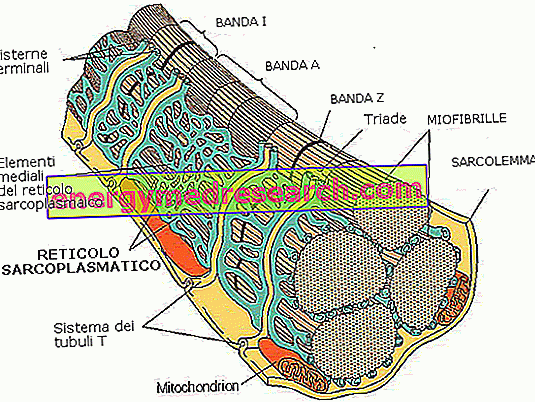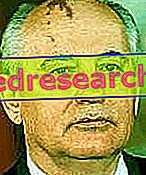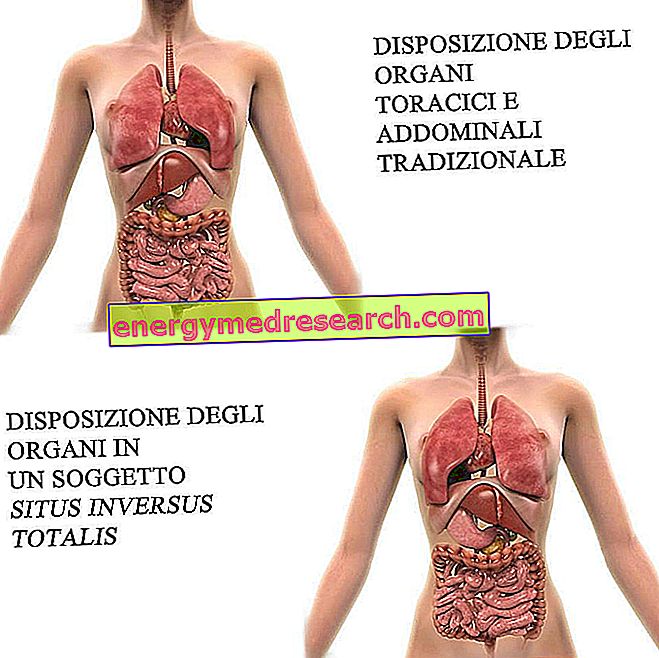In the previous section we saw how two regulatory proteins prevent the myosin heads from completing the strength stroke. Only the increase in calcium ions in the sarcoplasm allows the release of this "safety", by setting the switch to the "on" position. It is precisely the presence of calcium in the intracellular environment that determines the beginning of the complex chemo-mechanical events that underlie muscle contraction.
The increase in sarcoplasmic calcium is the end result of a fine nervous control. The trigger of the contraction occurs only when the skeletal muscle receives a signal from its motor nerve.
In addition to nerve structures, the presence of the so-called sarcoplasmic reticulum is very important. Inside we find a high concentration of calcium ions.
The sarcoplasmic reticulum
The sarcoplasmic reticulum is a canalicular network structure that completely envelops every muscle fiber, undermining the internal spaces between a myofibril and the other. Examining it carefully, it is possible to notice two particular structures:
RETICLES: they are formed by longitudinal canaliculi (which re-accumulate Ca2 + ions) which, anastomosed to each other, flow into larger tubular structures, called terminal cisterns, which concentrate and sequester Ca2 +, then release it when an adequate stimulus arrives.
TRANSVERSE TUBULES (T-shaped tubules): invaginations of the cell membrane (sarcolemma), closely associated with the terminal cisterns. The membrane that covers it, being in direct contact with the sarcolemma, is free to communicate with the extracellular fluid (outside the cell).
The complex TUBULO TRASVERSO + CISTERNE TERMINALI (placed at its sides) constitutes the so-called FUNCTIONAL TRIAD.
The particular structure of the transverse tubules allows the rapid transmission of the action potential, without latencies, inside the muscle fiber.
The transverse tubule is regulated by a voltage-dependent receptor protein, whose activation upon reaching the action potential stimulates the release of Ca2 + from the terminal cisterns. The increased concentration of these ions represents the initial event of muscle contraction.

The basics of muscle contraction
The nerve impulse, originated centrally and transported by motoenurons, reaches the level of the motive plate and propagates inside the muscle fiber thanks to the membranous tubular system. The action potential and the consequent depolarization of the sarcolemma determine the release of Ca2 + from the sarcoplasmic reticulum cisterns. These ions, interacting with the troponin-tropomyosin regulation system, cause the release of the active site on the actin and the consequent formation of the actomyosin bridges (see dedicated article).
Once the stimulus that gave rise to the contraction is exhausted, muscle relaxation occurs through an active dependent ATP process, which aims to bring back the calcium ions inside the sarcoplasmic reticulum (restoring the inhibitory effect of the troponin-tropomyosin system) and promote the dissolution of the actomyosin bridge.
Muscle innervation
The contraction of muscle fibers is the result of a nervous stimulus that runs through an alpha motor neuron until it reaches the driving plate. The cell body of this motor neuron is located in the ventral horn of the gray substance of the spinal cord.
More muscle fibers, united by similar anatomic-physiological characteristics, are innervated by a single motor neuron. Each of these fibers receives afferents from a single motor neuron.
The number of fibers controlled by the motor neuron is inversely proportional to the degree of fineness and precision of the movement required of the muscle that contains them. The extraocular muscles, for example, support the motility of the bulb with extreme precision; for this reason, each motor neuron innervates very few muscle fibers. In other body regions, where not as much finesse is required, the ratio can go from 1: 5 to 1: 2000 - 1: 3000. Generally speaking, the smaller the muscle and the smaller the motor unit is.
 | The complex formed by the alpha-spinal motor neuron, its efferent fiber (which exits and goes to the periphery transmitting the impulse) and the controlled muscle fibers, constitutes the simplest neurofunctional unit of the muscle, called: NEUROMOTORY UNIT. The neuromotor unit is the smallest functional entity of the muscle that can be controlled by the nervous system. |
Contrary to what one might think, the nerve fibers of a motor unit are not all directed at nearby fibers. In fact, muscle fibers belonging to a given unit are mixed with fibers that are part of other motor units. This particular arrangement allows a wider spatial distribution of the force generated by the motor units and a lower voltage between the fiber bundles.
Furthermore, the neuromotor units are not all the same. They are classified on the basis of the contraction time, the peak force generated, the relaxation time and the fatigue time. This makes it possible to distinguish the motor units in:
- type I lens (or S from "Slow" or SO from "Slow Glycolitic")
- fast type IIb (or FF from "Fast Fatiguing" or FG "Fast Glycolitic")
- Type IIa intermediate (or FR from "fast fatigue resistent" or FOG "Fast Oxidative Glycolitic").
Each motor unit is made up of muscle fibers with homogeneous characteristics. Resistant fibers, for example, are all made up of slow motor units, vice versa for fast ones.



